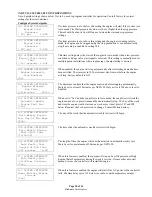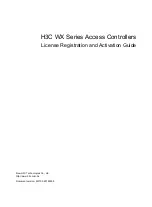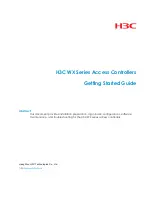
Page 5 of 34
File Name:
Doc#586p.docx
In case of Overspeed, the engine will be stopped and the
"Engine Overspeed"
light will illuminate and the alarm will sound.
The light and alarm will stay on until the Engine Speed Switch and the Controller are manually reset. To manually reset the
Controller, turn the controller selector switch to
Off
, then press the Reset button. Then turn the selector switch back to
“Auto”.
The Controller may be configured as either
"Manual"
or
"Automatic"
stop
as required (System Config Screen 104).
"Manual"
stop is set as standard. The current status of this setting is visible on the Main System Status Screen where the letter
“A” will appear in the upper right hand corner of the screen when set to Automatic Stop and an “M” will appear when set for
Manual stop. When Automatic stop is enabled the stop timer is preset at the factory to 30 minutes. Longer time settings can be
set in System Config screen 105 with a maximum setting of 60 minutes possible. When “Automatic Stop” is disabled, the
engine will continue to run even though the pressure switch or other remote starting switch returns to its normal position. The
engine can be stopped immediately only by pressing the stop button or by turning the Auto-Off-Manual switch to the
Off
position. On engines that do not use the “energize to stop” method (i.e. Caterpillar), the engine may also be stopped by turning
the circuit breakers BATT1 and BATT2 to OFF. If set up for
"Automatic"
stop, the engine will be stopped automatically upon
restoration to normal of whatever demand switch started the engine providing it has run at least 30 minutes or longer as set in
System Config screen 105. If the demand period was less than the time set on the auto stop timer, the engine will continue to
run until the timer times out and then will stop.
B.
When the
"Test"
mode button is pressed for two or more seconds, the engine will be started by causing a drop in water
pressure. Failure alarm circuits will be operative in the
"Test"
mode. This method of starting provides a test of the Controller,
thereby assuring proper operation when required. The engine will run for the time set in Auto Weekly Test Length Of Run Time
(System Config Screen 109) or until the
"Stop"
push button is pressed or the selector switch is turned to
“OFF”
.
C.
The
"Manual"
position of the Auto-Off-Manual switch is for manually starting the engine from either battery. The fuel and
water solenoids are energized in this position, and the engine must be cranked by pushing one of the buttons located below the
OID.
"Manual Crank 1"
cranks from Battery 1, and
"Manual Crank 2"
cranks from Battery 2. Pressing both buttons will
result in cranking from both batteries simultaneously.
D.
When the engine is given a command to stop for any reason, terminal 12 will energize and will remain on for approximately 15
seconds. The controller will not start until terminal 12 is de-energized again.
E.
Periodic Self Testing - The Test Run Timer can be set to give test runs on any day of the week and time of day desired. A
timing element is incorporated in the control so that when the engine starts in this manner, it will run for a definite time before it
shuts down. See System Config Screens 106 through 109 to set the starting time and length of engine running.
F.
Provision for sequential starting is accomplished by the use of adjustable time delay on pressure drop starting or “Deluge Valve”
starting. On Multiple Pump installations these timers are set sequentially and progressively longer in time to prevent more than
one (1) pump from starting simultaneously with another pump. Failure of the lead pump to start will not prevent subsequent
pumps from starting. The time delay on starting is set in System Config Screen 103.
G.
The “Pump On Demand” alarm light is provided to indicate that there is a command to start and run the additive pump
controller. This includes a low pressure condition, deluge valve start signal etc. The alarm light will clear when the start
condition has been cleared such as the water pressure in the system rises above the high set point set in screen 102.
H.
The “Contactor Coil Failure” alarm light is to annunciate a loss of continuity to the two engine starting contactors on the engine.
There is a low level DC current that is applied to field terminals #9 and #10 to detect continuity in the contactor coils. Should the
contactor coil open or fail, the “Contactor Coil Failure” LED will illuminate and the alarm horn will sound. In addition there will
be an entry in the Event log to indicate which Contactor coil has failed.
I.
The “Loss of DC Power” lamp is provided to indicate that both batteries have been disconnected or turned off but AC power is
still available. The alarm horn will also sound upon the loss of DC Power and can not be silenced.
J.
The “ECM Failure”,”ECM Warning”,“ECM Sw. in Alt.” and “ECM Injection Fault” alarms apply only to those engines that
have electronic fuel control. Should the Electronic Engine Control Module detect a problem, the appropriate alarm LED will
illuminate and sound the horn.
PART IV: INSTALLATION AND TEST PROCEDURE
A.
INSTALLATION
The Fire Pump Controller has been assembled and wired at the factory in accordance with the highest workmanship standards.
All circuits and functions have been thoroughly tested to assure correct operation when properly installed. The installer should
be completely familiar with the external hookup of the engine junction box to the terminal bar in the Controller. Various engine
components must be wired to the proper terminal in the controller using the correct size of stranded wire. An appropriate size






































